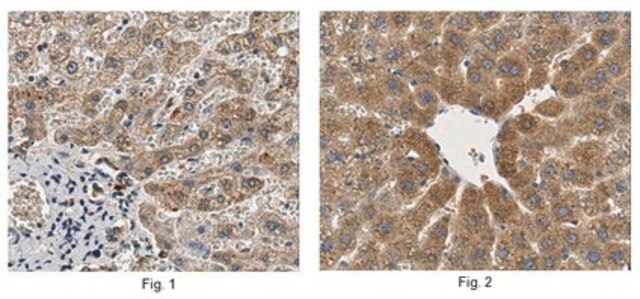推荐产品
生物源
mouse
品質等級
抗體表格
purified immunoglobulin
抗體產品種類
primary antibodies
無性繁殖
4D3.2, monoclonal
物種活性
human, rat
技術
immunohistochemistry: suitable (paraffin)
western blot: suitable
同型
IgG1κ
NCBI登錄號
UniProt登錄號
運輸包裝
wet ice
目標翻譯後修改
unmodified
基因資訊
human ... ADIPOR2(79602)
一般說明
Adiponectin receptor protein 2 (UniProt Q86V24; also known as Progestin and adipoQ receptor family member II) is encoded by the ADIPOR2 (also known as PAQR2) gene (Gene ID 79602) in human. Adiponectin receptor protein 1 & 2 (AdipoR1 & AdipoR2) are receptors for adiponectin, a well knonwn anti-inflammatory adipokine highly abundant in serum. Both AdipoR1 and AdipoR2 are reported to be ubiquitously expressed with the highest expression in skeletal muscle and liver, respectively. Circulating adiponectin levels are reduced in obesity and type II diabetes, whereas weight loss elevates serum adiponectin. Adiponectin deficiency in mice is reported to exacerbate metabolic dysfunction by diet-induced obesity in some studies, while adiponectin overexpression alleviates metabolic dysfunction independent of weight loss in both genetic and diet-induced animal models of obesity. Adipor1-knockout (KO) results in increased adiposity and decreased glucose clearance in mice, whereas Adipor2-KO mice are lean and displayed improved glucose clearance. In addition to its metabolic role, adiponectin deficiency is associated with various clinical cardiovascular disorders including myocardial infarction, peripheral artery disease, and endothelial dysfunction. In a study of murine hind limb ischemia model, blood flow recovery after chronic hind limb ischemic surgery is similar among wild-type and AdipoR1-KO mice, while revascularization in AdipoR2-KO mice is severely attenuated. Human AdipoR2 is a 7-transmembrane (a.a. 148-168, 182-202, 214-234, 246-266, 274-294, 310-330, 349-369) protein with the opposite topology of G protein-coupled receptors (GPCRs), having its N-terminal end at the cytoplasmic side (a.a. 1-147) and C-terminal end at the extracellular side (a.a. 370-386). Unlike GPCRs also, adipoR1 & AdipoR2 transmembrane helices are not kinked or tilted relative to the plane of the membrane.
特異性
Clone 4D3.2 targets an epitope within the N-terminal cytoplasmic domain.
免疫原
Epitope: N-terminal cytoplasmic domain.
GST-tagged recombinant human AdipoR2 N-terminal fragment.
應用
Immunohistochemistry Analysis: A 1:250 dilution from a representative lot detected AdipoR2 in human prostate cancer, as well as normal rat heart and human cerebral cortex tissue sections.
Research Category
Signaling
Signaling
Research Sub Category
Lipid Metabolism & Weight Regulation
Lipid Metabolism & Weight Regulation
This Anti-AdipoR2 Antibody, clone 4D3.2 is validated for use in Western Blotting, Immunohistochemistry (Paraffin) for the detection of AdipoR2.
品質
Evaluated by Western Blotting of GST-tagged human AdipoR2 N-terminal fragment.
Western Blotting Analysis: A 1:1000 dilution of this antibody detected 50 ng of GST-tagged recombinant human AdipoR2 N-terminal fragment.
Western Blotting Analysis: A 1:1000 dilution of this antibody detected 50 ng of GST-tagged recombinant human AdipoR2 N-terminal fragment.
標靶描述
43.88 kDa calculated.
外觀
Protein G purified.
Format: Purified
Purified mouse monoclonal IgG1κ antibody in buffer containing 0.1 M Tris-Glycine (pH 7.4), 150 mM NaCl with 0.05% sodium azide.
儲存和穩定性
Stable for 1 year at 2-8°C from date of receipt.
其他說明
Concentration: Please refer to lot specific datasheet.
免責聲明
Unless otherwise stated in our catalog or other company documentation accompanying the product(s), our products are intended for research use only and are not to be used for any other purpose, which includes but is not limited to, unauthorized commercial uses, in vitro diagnostic uses, ex vivo or in vivo therapeutic uses or any type of consumption or application to humans or animals.
未找到合适的产品?
试试我们的产品选型工具.
儲存類別代碼
12 - Non Combustible Liquids
水污染物質分類(WGK)
WGK 1
閃點(°F)
Not applicable
閃點(°C)
Not applicable
Kiyoharu J Miyagishima et al.
Communications biology, 4(1), 1360-1360 (2021-12-11)
Late-onset retinal degeneration (L-ORD) is an autosomal dominant disorder caused by a missense substitution in CTRP5. Distinctive clinical features include sub-retinal pigment epithelium (RPE) deposits, choroidal neovascularization, and RPE atrophy. In induced pluripotent stem cells-derived RPE from L-ORD patients (L-ORD-iRPE)
我们的科学家团队拥有各种研究领域经验,包括生命科学、材料科学、化学合成、色谱、分析及许多其他领域.
联系技术服务部门








